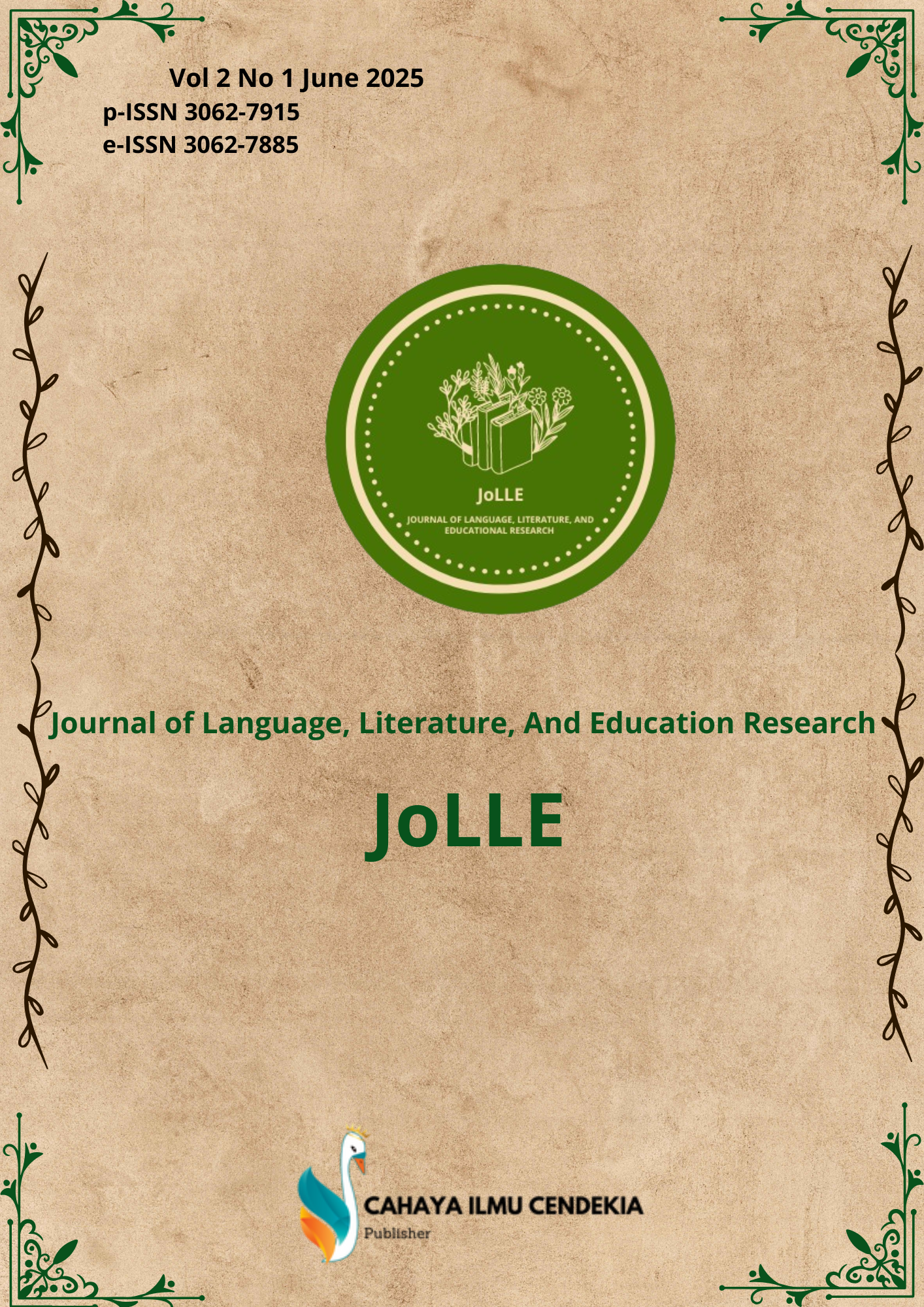The Use Of Audio Visual Media In Learning To Write Advertisement Texts Class Viii Students
Abstract
Purpose of the study: This study aims to determine the use of audio-visual media in teaching students to write advertisement texts in poster form for class VIII-6 students at SMPN 87 Jakarta during the 2018/2019 academic year.
Methodology: This study used a descriptive qualitative method. Data collection instruments included observation sheets, interview guidelines, assignments, and documentation. The data were analyzed using test and non-test analysis with data recap tables. The media used was a motion graphic video titled "Bahaya Rokok."
Main Findings: The first writing test without audio-visual media showed an average score of 7.1 with only 2 students reaching the passing score. In contrast, after implementing the motion graphic video in the second test, the average score increased to 8.6 with 33 students reaching the minimum passing score. The use of the video significantly improved students’ writing skills in advertisement texts.
Novelty/Originality of this study: This study introduces the use of motion graphic video as an innovative tool in language instruction, particularly in teaching advertisement texts. It offers empirical insight into how media can enhance writing engagement and outcomes, especially for texts with persuasive purposes in junior high school settings.
References
M. Alangari, S. Jaworska, and J. Laws, “Who’s afraid of phrasal verbs? The use of phrasal verbs in expert academic writing in the discipline of linguistics,” J. English Acad. Purp., vol. 43, p. 100814, 2020, doi: 10.1016/j.jeap.2019.100814.
P. E. Jones and C. Read, “Mythbusters united? A dialogue over Harris’s integrationist linguistics and Gibson’s Ecological Psychology,” Lang. Sci., vol. 97, p. 101536, 2023, doi: 10.1016/j.langsci.2023.101536.
T. T. Voorhees and O. Vorobel, “Integrating qualitative research into the community college linguistics course: An autoethnographic inquiry,” Int. J. Educ. Res. Open, vol. 2, no. June, p. 100053, 2021, doi: 10.1016/j.ijedro.2021.100053.
E. Leivada and E. Murphy, “Mind the (terminological) gap: 10 misused, ambiguous, or polysemous terms in linguistics,” Ampersand, vol. 8, p. 100073, 2021, doi: 10.1016/j.amper.2021.100073.
K. U. Isisag, “The efficacy of macro-linguistics in developing reading skills: An integrated lesson plan,” Procedia - Soc. Behav. Sci., vol. 9, pp. 698–703, 2010, doi: 10.1016/j.sbspro.2010.12.220.
C. G. Quan, “Continuing with the promise of ‘Scratch’ in the applied linguistics classroom,” Procedia - Soc. Behav. Sci., vol. 103, pp. 245–254, 2013, doi: 10.1016/j.sbspro.2013.10.332.
M. A. Candel-Mora and C. Vargas-Sierra, “An analysis of research production in corpus linguistics applied to translation,” Procedia - Soc. Behav. Sci., vol. 95, pp. 317–324, 2013, doi: 10.1016/j.sbspro.2013.10.653.
R. Z. Abid and S. A. Manan, Integrating corpus linguistics in critical literacy pedagogy: A case study of lance armstrong’s transformation from a titleholder to a fraud, vol. 208, no. Icllic 2014. Elsevier B.V., 2015. doi: 10.1016/j.sbspro.2015.11.189.
H. Jalali, “Reflection of stance through it bundles in applied linguistics,” Ampersand, vol. 4, pp. 30–39, 2017, doi: 10.1016/j.amper.2017.06.001.
M. Pikhart, “New horizons of intercultural communication: Applied linguistics approach,” Procedia - Soc. Behav. Sci., vol. 152, pp. 954–957, 2014, doi: 10.1016/j.sbspro.2014.09.349.
H. Bromhead, “Disaster linguistics, climate change semantics and public discourse studies: a semantically-enhanced discourse study of 2011 Queensland Floods,” Lang. Sci., vol. 85, p. 101381, 2021, doi: 10.1016/j.langsci.2021.101381.
A. M. Fazilatfar and Z. S. Naseri, “Rhetorical moves in applied linguistics articles and their corresponding iranian writer identity,” Procedia - Soc. Behav. Sci., vol. 98, pp. 489–498, 2014, doi: 10.1016/j.sbspro.2014.03.444.
K. Belousov, E. Erofeeva, T. Erofeeva, Y. Leshchenko, and N. Zelyanskaya, “University teachers of linguistics and self-image of their profession,” Procedia - Soc. Behav. Sci., vol. 214, no. June, pp. 667–676, 2015, doi: 10.1016/j.sbspro.2015.11.667.
X. Tian, A. E. Griffith, Z. Price, K. E. Boyer, and K. Tang, “Investigating linguistic alignment in collaborative dialogue: a study of syntactic and lexical patterns in middle school students,” Lang. Speech, 2024, doi: 10.1177/00238309241234565.
S. May, “New Zealand is ‘racist as f**k’: Linguistic racism and te reo Māori,” Ethnicities, vol. 23, no. 5, pp. 662–679, 2023, doi: 10.1177/14687968231192037.
I. Lenart, I. Markovina, and O. Endrody, “Age-related differences in Russian and Hungarian linguistic pictures of the world,” J. Eurasian Stud., vol. 16, no. 1, pp. 60–73, 2023, doi: 10.1177/18793665231221551.
R. Kopečková, U. Gut, M. Wrembel, and A. Balas, “Phonological cross-linguistic influence at the initial stages of L3 acquisition,” Second Lang. Res., vol. 39, no. 4, pp. 1107–1131, 2023, doi: 10.1177/02676583221123994.
J. Bosque-Gil, P. Cimiano, and M. Dojchinovski, “Editorial of the special issue on latest advancements in linguistic linked data,” Semant. Web, vol. 13, no. 6, pp. 911–916, 2022, doi: 10.3233/SW-223251.
D. Gromann et al., “Multilinguality and LLOD: A survey across linguistic description levels,” Semant. Web, vol. 1, no. 1, pp. 1915–1958, 2024, doi: 10.3233/SW-243591.
K. Bromberek-Dyzman, R. Jończyk, M. Vasileanu, A. G. Niculescu-Gorpin, and H. Bąk, “Cross-linguistic differences affect emotion and emotion-laden word processing: Evidence from Polish-English and Romanian-English bilinguals,” Int. J. Biling., vol. 25, no. 5, pp. 1161–1182, 2021, doi: 10.1177/1367006920987306.
M. P. Di Buono, H. Gonçalo Oliveira, V. Barbu Mititelu, B. Spahiu, and G. Nolano, “Paving the way for enriched metadata of linguistic linked data,” Semant. Web, vol. 13, no. 6, pp. 1133–1157, 2022, doi: 10.3233/SW-222994.
C. Yue, “We make viewpoints in different ways: the use of stance adverbials across academic levels and disciplines,” Cogent Arts Humanit., vol. 11, no. 1, p., 2024, doi: 10.1080/23311983.2024.2435169.
L. Zhao and P. Issra, “Traditional Chinese Medicine (TCM) research articles unpacked: a systemic functional linguistics (SFL) elemental genre approach,” Cogent Arts Humanit., vol. 11, no. 1, p., 2024, doi: 10.1080/23311983.2024.2317617.
D. A. S. El-Dakhs, L. Mardini, and L. Alhabbad, “The persuasive strategies in more and less prestigious linguistics journals: focus on research article abstracts,” Cogent Arts Humanit., vol. 11, no. 1, p., 2024, doi: 10.1080/23311983.2024.2325760.
Hendrokumoro, F. Darman, N. Nuraeni, and N. K. Ma’shumah, “The genetic relationship between alune, lisabata, luhu, and wemale (western seram, Indonesia): A historical-comparative linguistics approach,” Cogent Arts Humanit., vol. 11, no. 1, p., 2024, doi: 10.1080/23311983.2024.2306718.
L. Fontaine, “On prepositions and particles: A case for lexical representation in systemic functional linguistics,” Word, vol. 63, no. 2, pp. 115–135, 2017, doi: 10.1080/00437956.2017.1309029.
I. Mukahal and M. M. Idrus, “Negation forms in the poetry of philip larkin,” Comp. Lit. East West, vol. 8, no. 2, pp. 207–220, 2024, doi: 10.1080/25723618.2024.2395216.
R. Nhongo and L. Siziba, “Intellectualising African languages in literature and linguistics at selected Zimbabwean higher learning institutions,” South African J. African Lang., vol. 44, no. 3, pp. 223–230, 2024, doi: 10.1080/02572117.2024.2385262.
M. Diko, “Harmonizing Africa’s linguistic symphony: navigating the complexities of translating African literature using a postcolonial theory,” Cogent Arts Humanit., vol. 11, no. 1, p., 2024, doi: 10.1080/23311983.2024.2411871.
T. Popescu, “Developing english linguistics students’ translation competence through the language learning process,” Procedia - Soc. Behav. Sci., vol. 93, pp. 1075–1079, 2013, doi: 10.1016/j.sbspro.2013.09.333.
Z. E. Attia, A. M. Gadallah, and H. M. Hefny, “An enhanced multi-view fuzzy information retrieval model based on linguistics,” IERI Procedia, vol. 7, pp. 90–95, 2014, doi: 10.1016/j.ieri.2014.08.015.
Z. Seifoori and J. Fattahi, “The comparison of the method section of applied linguistics articles written by native and iranian writers in terms of grammatical complexity and clause types,” Procedia - Soc. Behav. Sci., vol. 98, pp. 1698–1705, 2014, doi: 10.1016/j.sbspro.2014.03.596.
J. M.-H. Lim, J. M. Storey, S.-L. Chang, M. S. Esa, and S. A. Damit, “Preface: Multiple roles of language and linguistics in society,” Procedia - Soc. Behav. Sci., vol. 134, no. Iclalis 2013, pp. 1–2, 2014, doi: 10.1016/j.sbspro.2014.04.217.
L. Wang, “Designing and implementing outcome-based learning in a linguistics course: A case study in Hong Kong,” Procedia - Soc. Behav. Sci., vol. 12, pp. 9–18, 2011, doi: 10.1016/j.sbspro.2011.02.004.
A. V. Tsepilova and L. V. Mikhaleva, “Working with formulaic language as a way to evaluate and improve EFL non-linguistics students’ pragmatic skills in a culture-specific contextual situation,” Procedia - Soc. Behav. Sci., vol. 200, no. October, pp. 550–556, 2015, doi: 10.1016/j.sbspro.2015.08.022.
Y. Wang and J. Soler, “Investigating predatory publishing in political science: a corpus linguistics approach,” Appl. Corpus Linguist., vol. 1, no. 1, p. 100001, 2021, doi: 10.1016/j.acorp.2021.100001.
S. Pesina and T. Solonchak, “Concept in cognitive linguistics and biocognitive science,” Procedia - Soc. Behav. Sci., vol. 192, no. 3519, pp. 587–592, 2015, doi: 10.1016/j.sbspro.2015.06.100.
R. Alshalan and H. S. Alyousef, “Enhancing English–Arabic translator education through systemic functional linguistics: a study in a Saudi undergraduate classroom,” Saudi J. Lang. Stud., 2025, doi: 10.1108/sjls-09-2024-0054.
A. Q. Al Darwesh, “The representation of authorial and external voice in popular science book writing: a systemic functional linguistics approach,” Saudi J. Lang. Stud., vol. 5, no. 2, pp. 108–127, 2025, doi: 10.1108/sjls-08-2024-0043.
A. Sendra, E. Late, and S. Kumpulainen, “From data lifecycle to research activity model: research data management in data-intensive social sciences and humanities research,” Aslib J. Inf. Manag., 2025, doi: 10.1108/AJIM-12-2024-0959.
O. A. J. Mascarenhas, M. Thakur, and P. Kumar, “On assumptions, presumptions, suppositions, and presuppositions,” A Prim. Crit. Think. Bus. Ethics, pp. 223–253, 2024, doi: 10.1108/978-1-83753-346-620241008.
L. Capoani, M. Fantinelli, and L. Giordano, “The concept of resilience in economics: a comprehensive analysis and systematic review of economic literature,” Contin. Resil. Rev., 2025, doi: 10.1108/crr-11-2024-0045.
N. A. Nawawi and S.-H. Ting, “Interactional metadiscourse markers in political science and creative arts journal abstracts,” Saudi J. Lang. Stud., vol. 5, no. 2, pp. 76–90, 2025, doi: 10.1108/sjls-09-2024-0052.
K. Berglund, M. Bertilsson, U. Hermansson, M. Sager, E. Wikstrom, and G. Hensing, “Determinants of alcohol preventive actions by managers: a cross-sectional study among Swedish managers,” Int. J. Work. Heal. Manag., no. 220180, 2025, doi: 10.1108/IJWHM-12-2024-0258.
K. M. Al-Balushi, “Teaching english as discourse in Sultan Qaboos University,” Learn. Teach. High. Educ. Gulf Perspect., vol. 7, no. 1, pp. 30–41, 2010, doi: 10.18538/lthe.v7.n1.18.
A. H. Al-Hoorie and A. A. K. AlAwdah, “Transdisciplinary integration for applied linguistics: the case of electrophysiology,” Saudi J. Lang. Stud., vol. 4, no. 2, pp. 97–105, 2024, doi: 10.1108/sjls-06-2024-0028.
A. A. Zughaibi, “The barefoot shoemaker’s son: examining EFL teachers’ pragmatic competence in a Saudi context,” Saudi J. Lang. Stud., vol. 2, no. 2, pp. 68–83, 2022, doi: 10.1108/sjls-02-2022-0013.
H. A. Al Fadda, R. O. A. Haliem, H. S. Mahdi, and R. Alkhammash, “Undergraduates vs. postgraduates attitudes toward cooperative learning in online classes in different settings,” PSU Res. Rev., vol. 8, no. 3, pp. 577–591, 2024, doi: 10.1108/PRR-05-2022-0052.
Copyright (c) 2025 Siti Nurafifah, Widiastuti Widiastuti

This work is licensed under a Creative Commons Attribution 4.0 International License.
Authors who publish with this journal agree to the following terms:
- Authors retain copyright and acknowledge that the Journal of Language, Literature, and Educational Research is the first publisher licensed under a Creative Commons Attribution 4.0 International License.
- Authors are able to enter into separate, additional contractual arrangements for the non-exclusive distribution of the journal's published version of the work (e.g., post it to an institutional repository or publish it in a book), with an acknowledgment of its initial publication in this journal.
- Authors are permitted and encouraged to post their work online (e.g., in institutional repositories or on their website) prior to and during the submission process, as it can lead to productive exchanges and earlier and greater citation of published work.


1.png)

.png)
.png)







